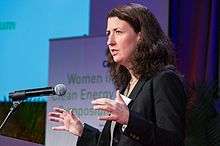Tracey Holloway
Tracey Holloway is Gaylord Nelson Distinguished Professor at the Nelson Institute for Environmental Studies at the University of Wisconsin-Madison and Department of Atmospheric and Ocean Sciences. Her research focuses on the links between regional air quality, energy, and climate through the use of computer models and date from satellites.[1]
Tracey Holloway | |
|---|---|
 Tracey Holloway at the Women in Clean Energy Symposium, 2012 | |
| Education | Brown University Princeton University |
Holloway earned a bachelor's degree in Applied Math from Brown University and PhD in Atmospheric and Oceanic Sciences from Princeton University in 2001. She was a postdoctoral scholar at the Earth Institute at Columbia University.[2] She currently also serves as the Team Leader for the NASA Health and Air Quality Applied Science Team (HAQAST) and lead efforts to promote the Energy Analysis and Policy (EAP) graduate certificate program in the Nelson Institute Holloway was one of five women who founded Earth Science Women's Network in 2002, which as of 2017 had around 3,000 members.[3][4]
Holloway served as Leopold Fellow in 2011,[5] a AAAS, received the first MIT Clean Energy Education and Empowerment Award in Education and Mentoring in 2018,[6] and was a Leshner Leadership Fellow in 2016-2017.
In May 2017, she co-authored a study in Environmental Science & Technology[7] that associated increased air conditioning use with increased levels of nitrogen oxides, sulfur dioxide, and carbon dioxide in the air.[8]
References
- Magnus, Amanda (March 21, 2017). "Creating A Network For Women In Science". Wisconsin Public Radio.
- "Former Earth Institute Postdocs"
- Gewin, Virginia (10 April 2014). "Turning point: Tracey Holloway". Nature. 508 (7495): 277. doi:10.1038/nj7495-277a.
- "Local Women: Global Impact". Brava Magazine. 1 May 2017.
- "Tracey Holloway | The Leopold Leadership Program". leopoldleadership.stanford.edu. Retrieved 2016-12-15.
- Chandler, David. "Symposium shows women's growing impact on clean energy worldwide" (PDF) (Autumn 2012). MIT Energy Initiative. Energy Futures. Retrieved 27 October 2016.
- Abel, David; Holloway, Tracey; Kladar, Ryan M.; Meier, Paul; Ahl, Doug; Harkey, Monica; Patz, Jonathan (2017-05-16). "Response of Power Plant Emissions to Ambient Temperature in the Eastern United States". Environmental Science & Technology. 51 (10): 5838–5846. Bibcode:2017EnST...51.5838A. doi:10.1021/acs.est.6b06201. ISSN 0013-936X. PMID 28466642.
- "Study measures air pollution increase attributable to air conditioning". news.wisc.edu. Retrieved 2017-10-01.
External links
- Official website (University of Wisconsin Madison College of Engineering)
- Biography (NASA Health and Air Quality Applied Sciences Team)